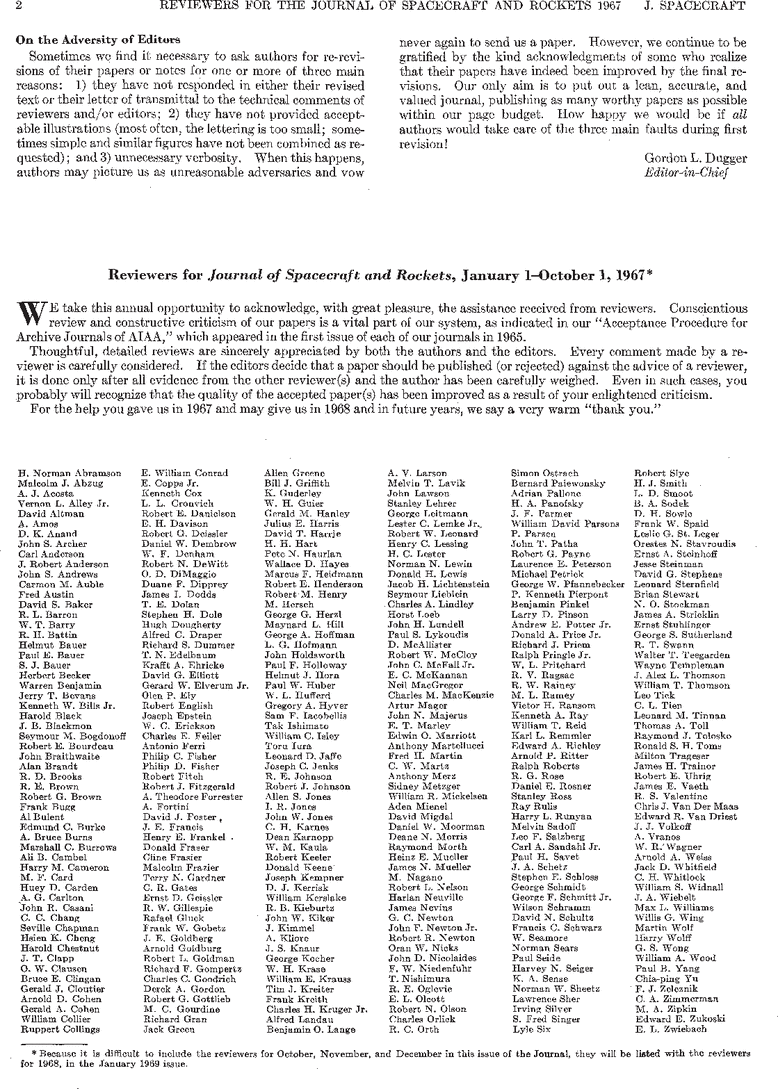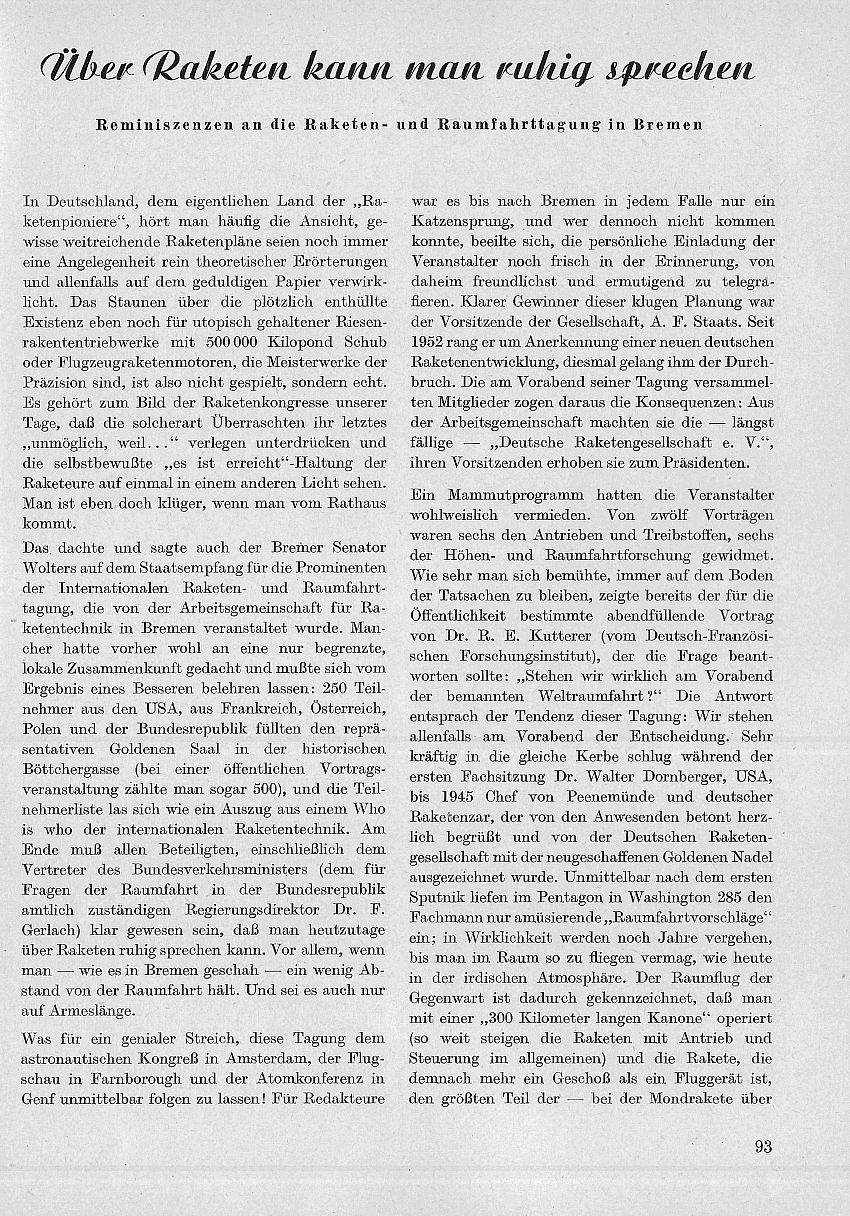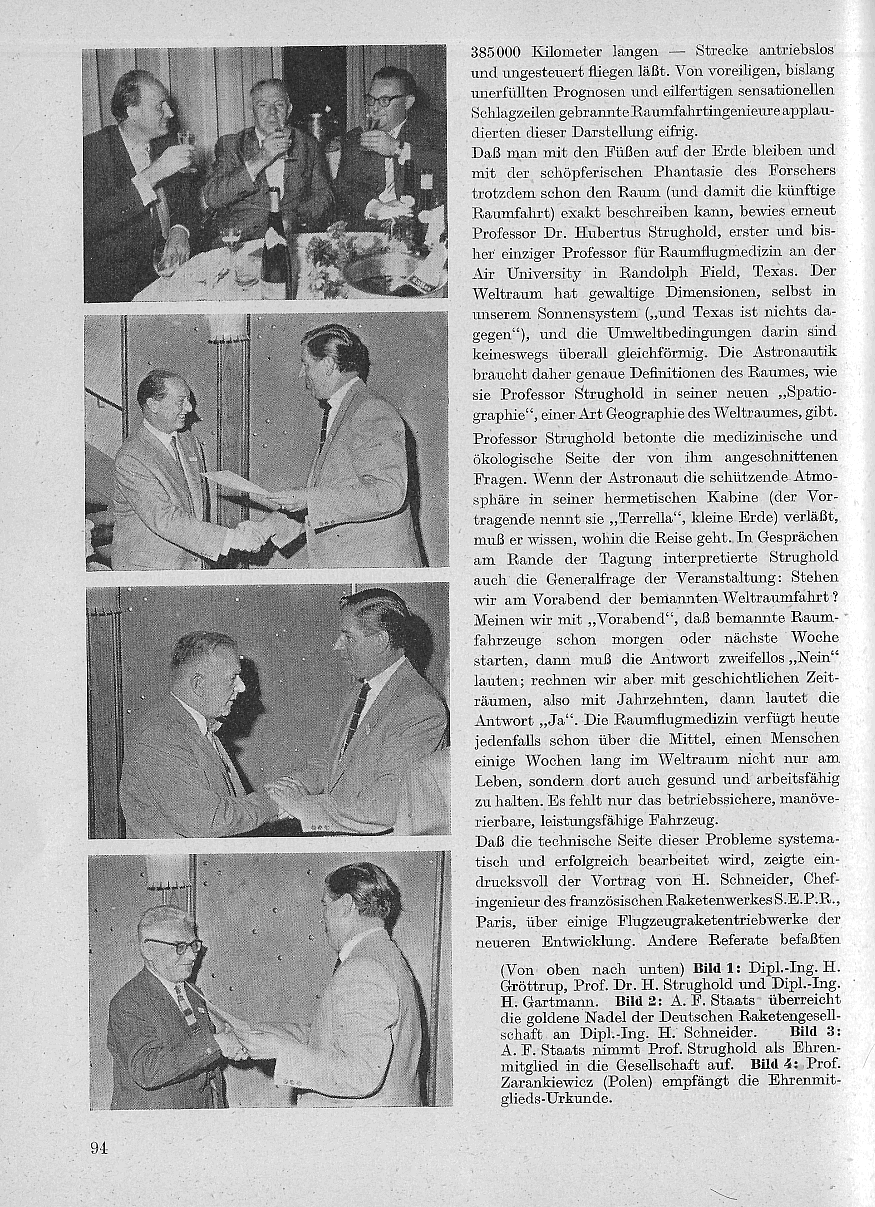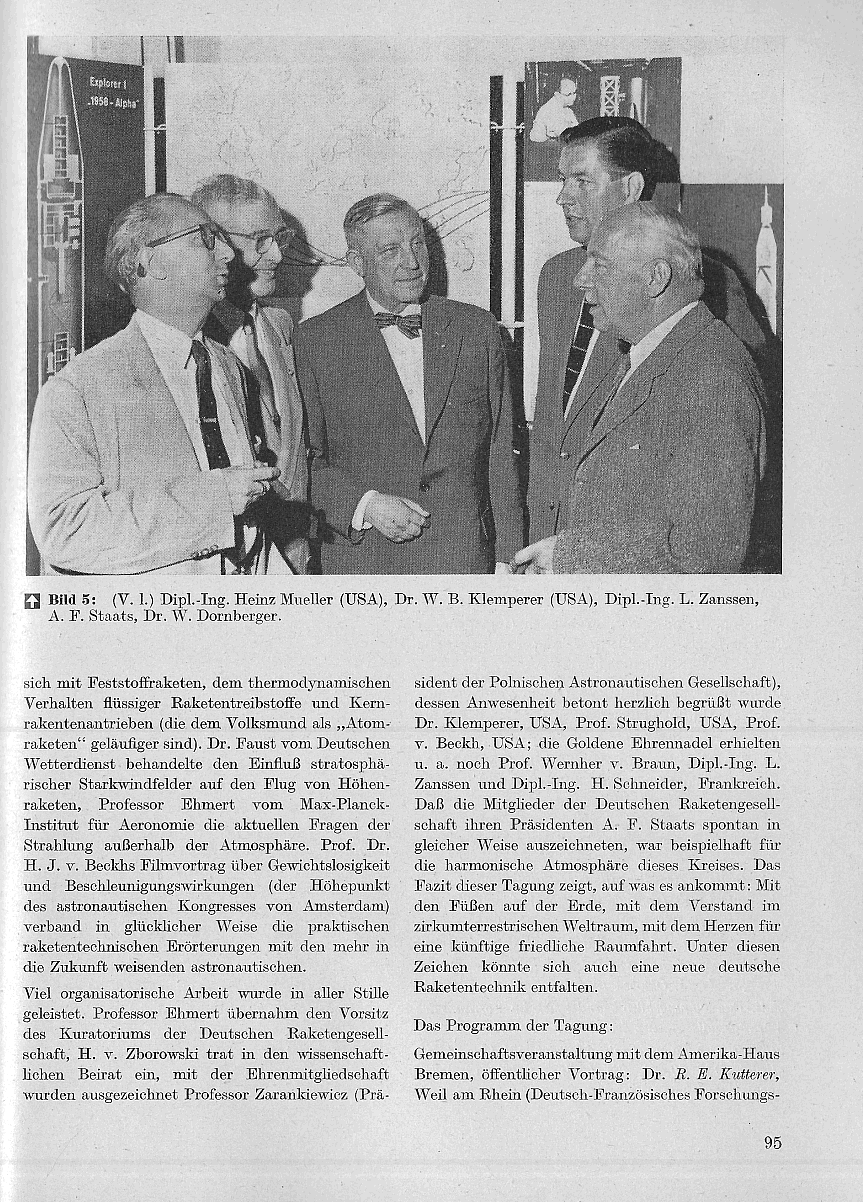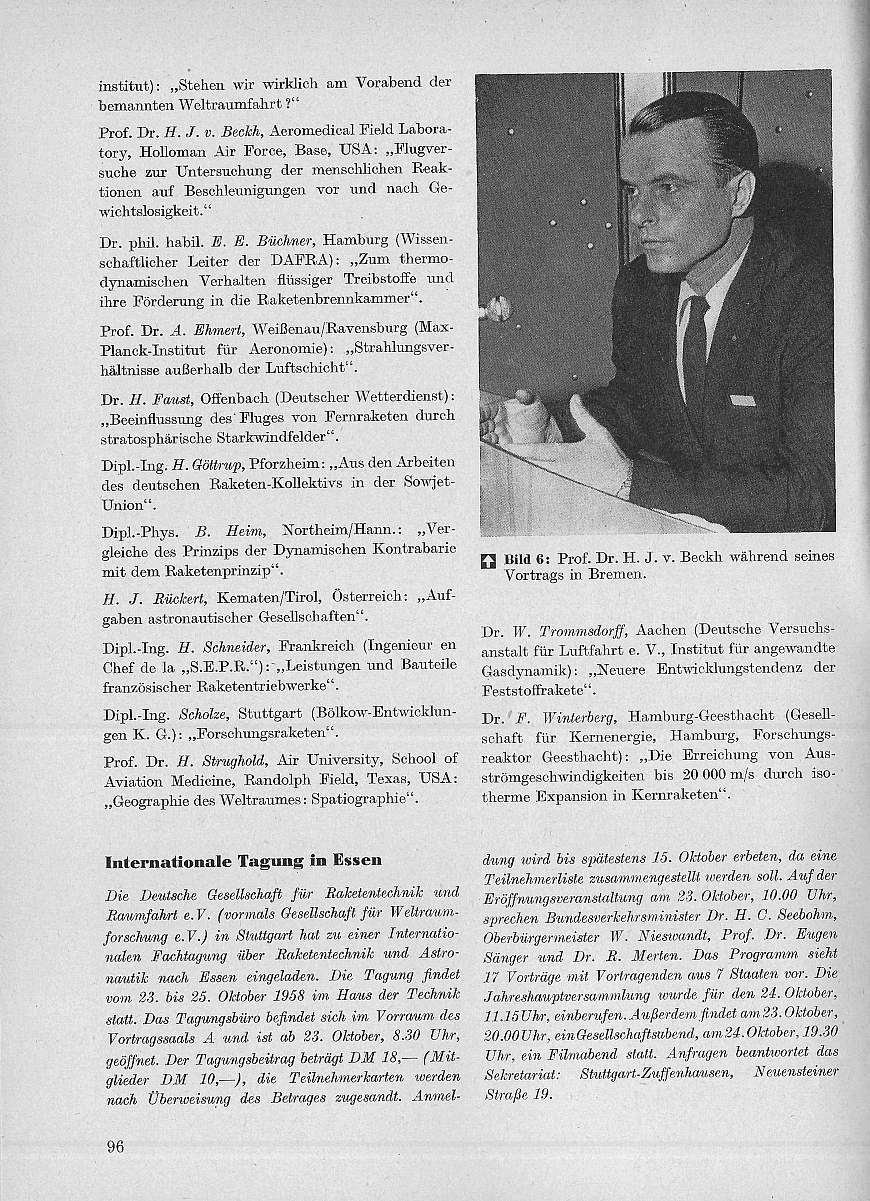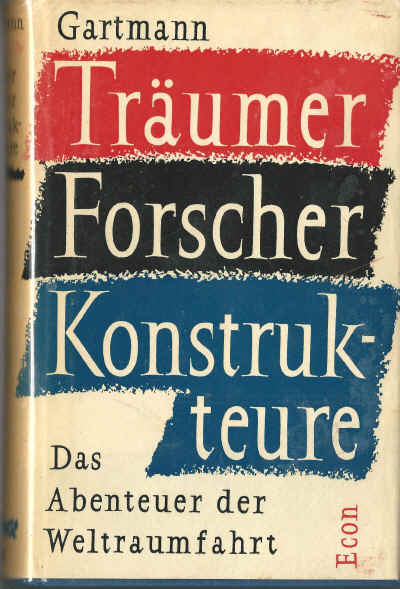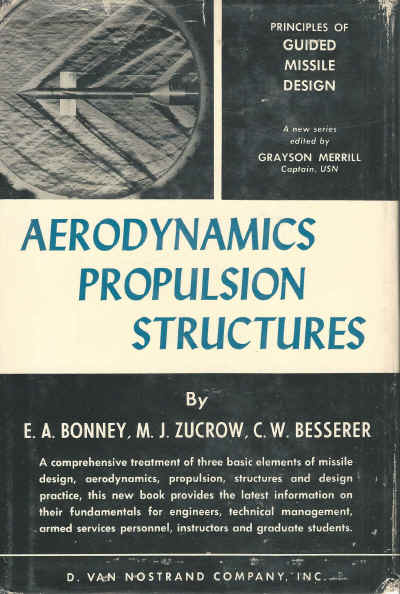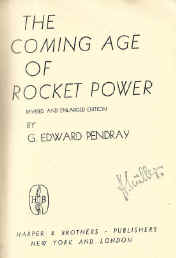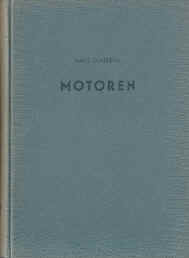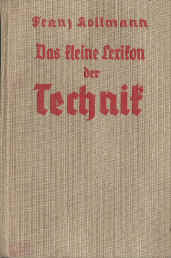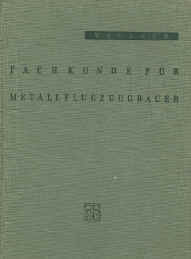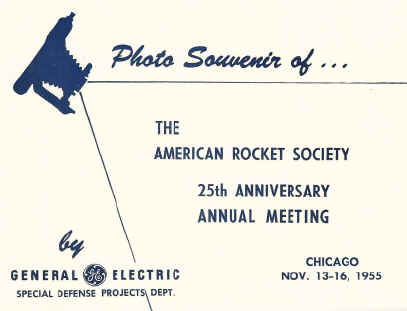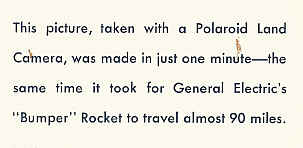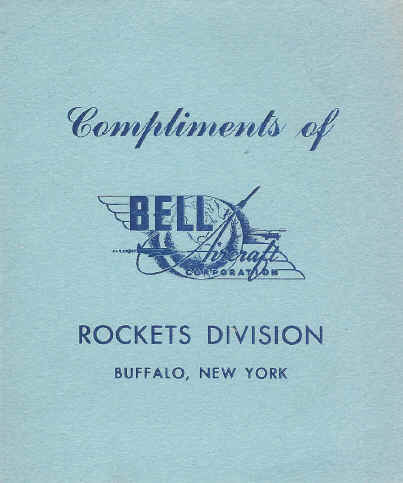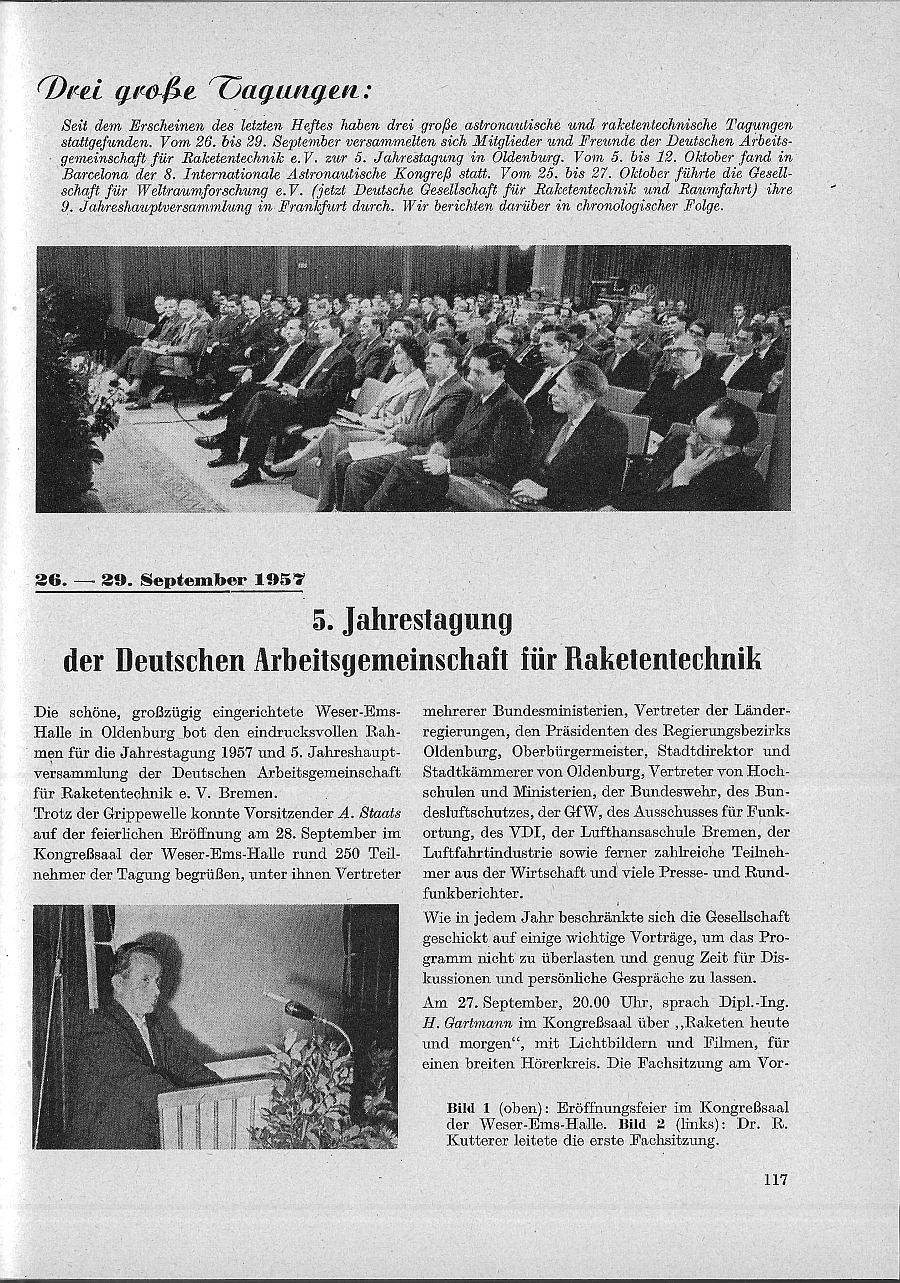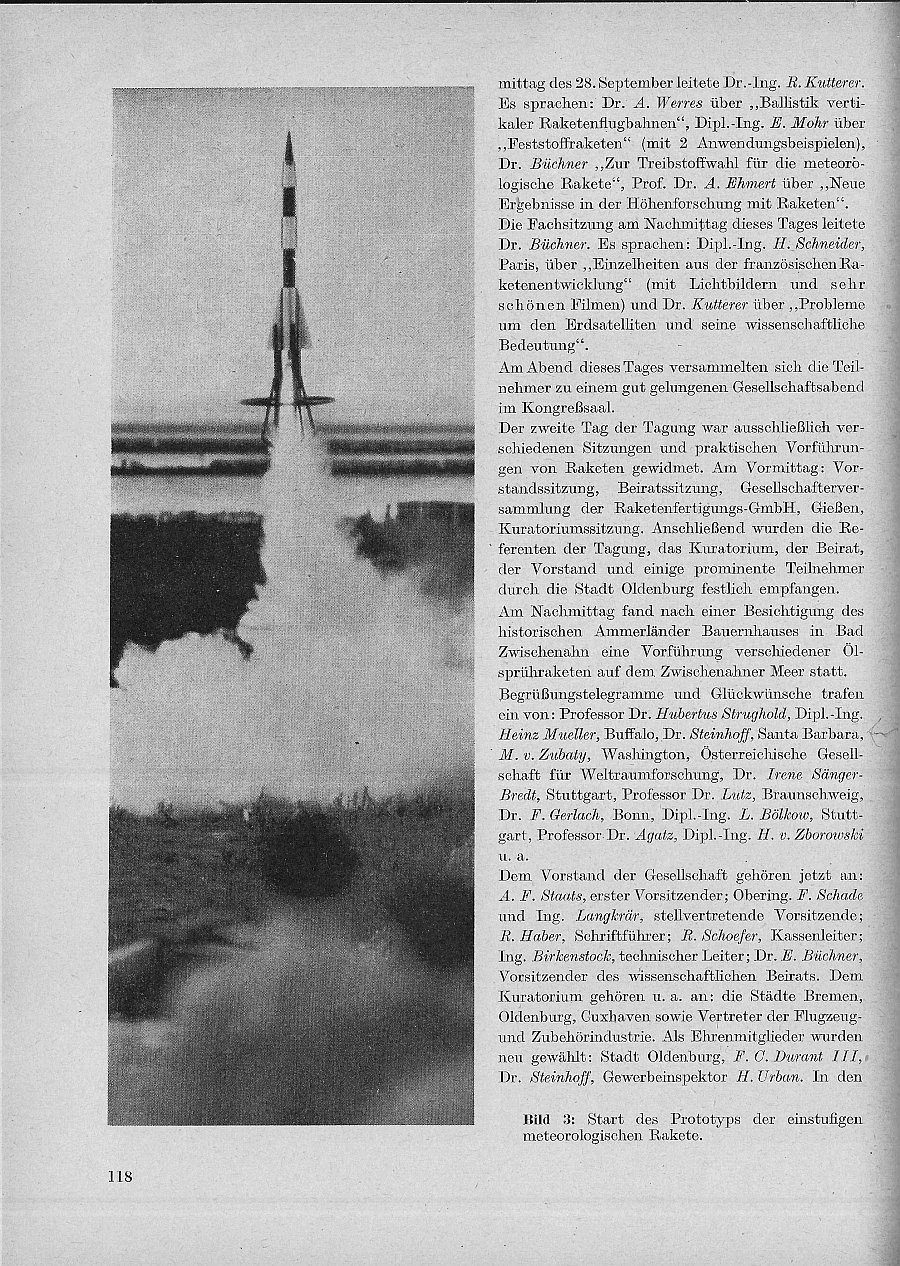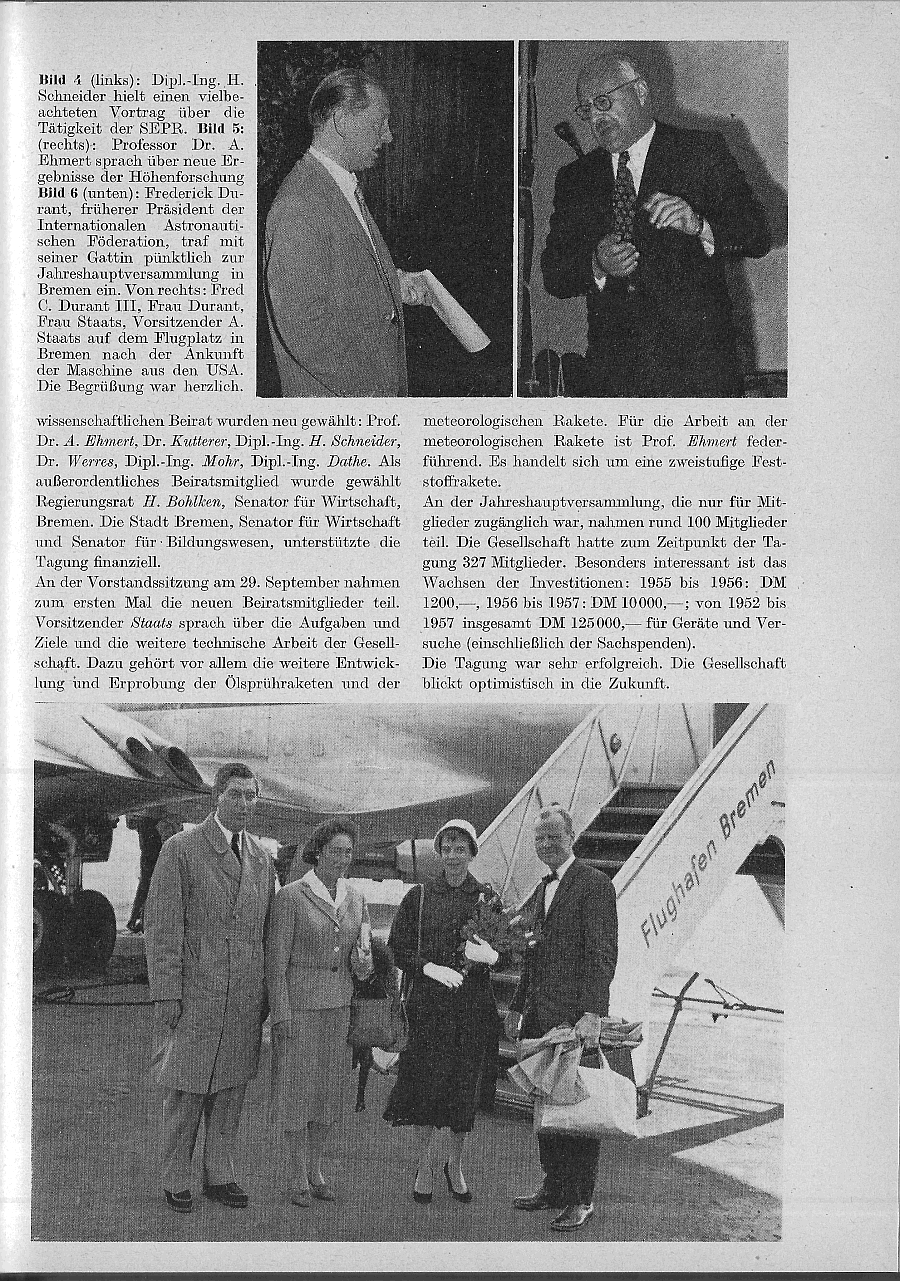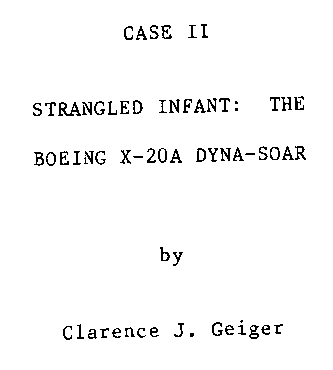|
|||||||||
|
|||||||||
Ignition An informal history of liquid rocket propellants By John D. Clark Intro Re John D. Clark ix Preface xi 1 How It Started 3 2 Peenemunde and JPL 12 3 The Hunting of the Hypergol . . . 24 4 .. . and Its Mate 47 5 Peroxide — Always a Bridesmaid 66 6 Halogens and Politics and Deep Space 72 7 Performance 90 8 Lox and Flox and Cryogenics in General 103 9 What Ivan Was Doing 115 10 "Exotics" 120 11 The Hopeful Monoprops 131 12 High Density and the Higher Foolishness 174 13 What Happens Next 190 Glossary 193 Index 197 2 Peenemunde and JPL Von Braun started work on his PhD thesis (rocket combustion processes) in November 1932. All of his experimental work was done at Kummersdorf-West, an artillery range near Berlin —and the Reichswehr paid the freight, and built up a rocket establishment around him. When he got his degree, in 1937, he was made the technical director of the organization, which was soon moved to Peenemunde. There the A-4, better known by its propaganda name "V-2" was designed and developed. Very little propellant development was involved in the A-4. From the beginning, liquid oxygen was the intended oxidizer, and 70-30 alcohol-water mixture (as had been used by the VfR) the fuel. And Helmuth Walter's 80 percent hydrogen peroxide was used to drive the fuel pumps. The peroxide entered a decomposition chamber, where it was mixed with a small quantity of a solution of calcium permanganate in water. This catalyzed its decomposition into oxygen and superheated steam, which drove the turbines which drove the pumps which forced the oxygen and the alcohol into the main combustion chamber. The A-4 was a long range strategic weapon, not designed to be fired at a moment's notice. It was perfectly practical to set it up, and then load it with alcohol and oxygen just before firing. But the Reichswehr needed antiaircraft rockets that were always ready to fire. When you get word from your forward observers that the bombers are on the way, you don't have time to load up a missile with liquid oxygen. What you need is a storable propellant—one Peenemunde and JPL 13 that can be loaded into the tanks beforehand — and kept there until you push the button. You can't do that with oxygen, which cannot be kept liquid above —119°C, its critical temperature, by any pressure whatsoever. The Reichswehr was rather slow to realize the need for AA rockets — maybe they believed Hermann Goering when he boasted, "If the British ever bomb Berlin, you can call me Meyer!" —but when they did they found that work on storable propellants was well under way. It was, at first, concentrated at Helmuth Walter's Witte Werke at Kiel. As has been mentioned, high strength hydrogen peroxide (80-83 percent) first became available in about 1934, and Walter had fired it as a monopropellant, and the Luftwaffe was immensely interested. Like General Arnold, in the U.S. they could appreciate the fact that a JATO rocket would enable a bomber to take off with a heavier load than it could normally carry, and by February 1937, a Walter hydrogen peroxide JATO had helped a Heinkel Kadett airplane to get off the ground. Later in the year, a rocket powered airplane was flown — again using a hydrogen peroxide motor. The Messerschmitt 163-A interceptor used the same propellant. But peroxide is not only a monopropellant, it's also a pretty good oxidizer. And Walter worked out a fuel for it that he called "C-Stoff." (The peroxide itself was called "T-Stoff.") Hydrazine hydrate, N2H4-H2O ignited spontaneously when it came in contact with peroxide (Walter was probably the first propellant man to discover such a phenomenon) and C-Stoff consisted of 30 percent hydrazine hydrate, 57 of methanol, and 13 of water, plus thirty milligrams per liter of copper as potassium cuprocyanide, to act as an ignition and combustion catalyst. The reason for the methanol and the water was the fact that hydrazine hydrate was hard to come by — so hard, in fact, that by the end of the war its percentage in C-Stoff was down to fifteen. The Messerschmitt 163-B interceptor used C-Stoff and T-Stoff. The next organization to get into the rocket business was the Aeronautical Research Institute at Braunschweig. There, in 1937-38, Dr. Otto Lutz and Dr. Wolfgang C. Noeggerath started to work on the C-Stoff-T-Stoff combination. Next, BMW (Bavarian Motor Worksyes, the people who make the motorcycles) were invited by the Luftwaffe to get into the act. Helmut Philip von Zborowski, the nephew of the famous pre-World War 1 racing driver, was in charge of the operation, and Heinz Mueller was his second. In the summer of 1939 BMW got a contract to develop a JATO unit, using the C-T-Stoff combination, and they worked with it for some months. But von Zborowski was convinced that 98 percent nitric acid was the better oxi14 Ignition dizer, as well as being immensely easier to get (LG. Farben guaranteed unlimited quantities), and set out to convert the brass to his point of view. From the beginning of 1940, he and Mueller worked on the nitric acid-methanol combination, and in 1941 proved his point, convincingly, with a perfect thirty-second run at the three thousand pounds force thrust level. He even convinced Eugen Sanger, who was sure that oxygen was the only oxidizer worth thinking about. And in the meantime, early in 1940, he and Mueller had made an immensely important discovery — that certain fuels (aniline and turpentine were the first they found) ignited spontaneously upon contact with nitric acid. Noeggerath learned of this, and joined the BMW people in their search for fuels with this interesting property. His code name for nitric acid was "Ignol" and for his fuels "Ergol," and, a fast man with a Greek root, he came up with "Hypergol" for the spontaneous igniters. "Hypergol" and its derivatives, such as the adjective "hypergolic" have become a permanent part not only of the German, but of the English language, and even, in spite of the efforts of Charles de Gaulle to keep the language "pure," of the French as well. The discovery of hypergolicity was of major importance. Running a rocket motor is relatively easy. Shutting it down without blowing something up is harder. But starting it up without disaster is a real problem. Sometimes electrical igniters are used — sometimes pyrotechnic devices. But neither can always be trusted, and either is a nuisance, an added complication, when you already have more complications than you want. Obviously, if your combination is hypergolic, you can throw out all the ignition schemes and devices, and let the chemistry do the work. The whole business is much simpler and more reliable. But as usual, there's a catch. If your propellants flow into the chamber and ignite immediately, you're in business. But if they flow in, collect in a puddle, and then ignite, you have an explosion which generally demolishes the engine and its immediate surroundings. The accepted euphemism for this sequence of events is a "hard start." Thus, a hypergolic combustion must be very fast, or it is worse than useless. The Germans set an upper limit of 50 milliseconds on the ignition delay that they could tolerate. Incidentally, and to keep the record straight, Zborowski named his propellants after plants. Nitric acid he called "Salbei" for sage, and his fuels "Tonka," after the bean from which coumarin, which smells like vanilla, is extracted. Considering the odors of the things he worked with, I can't think of more inappropriate namesl Peenemunde and JPL 15 The first ignition delay tests were, to put it mildly, somewhat primitive. After a long night session, searching through old chemistry texts for substances that were violently reactive with nitric acid, Zborowski and Mueller would soak a wiping rag with a promising candidate and spray it with nitric acid and see how quickly —or if—it burst into flames. And they ran into a peculiar phenomenon. An old, used wiping rag from the machine shop would sometimes ignite much faster than a new clean one soaked with the same fuel. Their chemistry laboratory furnished them with the answer. Traces of iron and copper from the shop, as the metals or as salts, catalyzed the ignition reaction. So they modified their 98 percent nitric acid, "Salbei" by adding to it 6 percent of hydrated ferric chloride, and called the new oxidizer "Salbeik." The wiping-rag technique was soon supplanted by a somewhat more sophisticated gadget with which you could drop a single drop of a candidate fuel into a thimbleful of acid, and determine its hypergolic properties with less risk of setting fire to the whole shop, and for the next four years BMW on the one hand and Noeggerath on the other were trying the hypergolicity of everything they could lay their hands on. At BMW, where propellant development was directed by Hermann Hemesath, more than 2000 prospective fuels were tried. And very soon the I.G. Farben organization at Ludwigshaven started doing the same thing. With a deplorable lack of imagination, Farben eschewed code names at first, and labeled their mixtures with code numbers likeT93/4411. The fuels that the three organizations developed were many and various, but at the same time very much alike, since there was a limited number of compounds which were hypergolic with nitric acid — and available in any quantity. Tertiary amines, such as triethyl amine were hypergolic, and aromatic amines, such as aniline, toluidine, xylidine, N methyl aniline were even more so. Most of the mixtures tried — neat fuels consisting of a single pure compound were unheard of— were based on the aniline family, frequently with the addition of triethylamine, plus, at times, things like xylene, benzene, gasoline, tetrahydrofuran, pyrocatechol, and occasionally other aliphatic amines. The BMW Tonka 250 comprised 57 percent of raw xylidine and 43 of triethylamine (it was used in the "Taifun" missile) and Tonka 500 contained toluidine, triethylamine, aniline, gasoline, benzene, and raw xylidine. Noeggerath added furfuryl alcohol to Tonka 250 to get "Ergol-60" which he considered the "best" hypergol, and reported, somewhat wistfully, that furfuryl alcohol was readily available in the United States—as it was not in Germany. 16 Ignition As soon as one of the investigators found a mixture that he liked he applied for a patent on it. (Such an application would probably not even be considered under the much stricter U.S. patent laws.) Not surprisingly, everybody and Hemesath and Noeggerath in particular, was soon accusing everybody else of stealing his patent. In 1946, when Heinz Mueller came to this country, he met Noeggerath again, and found him still indignant, bursting out with "And BMW, especially Hemesath, did swipe a lot of patents from us!" Around 1942 or 1943 I.G. Farben shifted the emphasis of their fuel work away from the mixtures they had been working with at first, and which were so similar to the Tonkas and the Ergols, to a series of fuels based on the "Visols," which were vinyl ethers. The vinyl ethers were very rapidly hypergolic with MS-IO, a mixed acid consisting of 10 percent sulfuric acid and 90 percent nitric, and the ignition delay was less sensitive to temperature than it was with straight nitric. (This had been a serious problem. A propellant pair might ignite in 50 milliseconds at room temperature, and wait around a whole second at 40 below.) Also, it was believed, practically as an article of faith, that MS-10 did not corrode stainless steel. This was a delusion that lasted five years before it was punctured. A typical mixture, patented by Dr. Heller in 1943, consisted of 57.5 percent Visol-1 (vinylbutyl ether) or Visol-6 (vinylethyl ether) 25.8 percent Visol-4 (divinylbutanediolether) 15 percent aniline, and 1.7 percent of iron pentacarbonyl or iron naphthenate. (Heller had to put his iron catalyst in his fuel rather than in his oxidizer, since the latter contained sulfuric acid, and iron sulfates are insoluble in nitric acid.) There were many variations on these fuels, vinylisobutyl ether being substituted at times for the n-butyl compound. All in all, more than 200 mixtures were tried, of which less than ten were found satisfactory. "Optolin" was a mixture of aniline, a Visol, aromatics, sometimes amines, gasoline, and pyrocatechol. The Wasserfall SAM used a Visol fuel. Several agencies tried to discover additives which, in small quantities, would make gasoline or benzene or methanol hypergolic with acid. Things like iron carbonyl and sodium selenide were more or less successful, but the success was academic at best, since the useful additives were all either too rare, too expensive, or too active to live with. But nitric acid was definitely the winner. Many German missiles were designed, at first, to use peroxide, but as the war went on, the Walter Type XVII submarines threatened to use up the whole production, and as the nitric acid work was so successful, the shift to the Peenemunde and JPL 17 latter oxidizer for missile work was inevitable. During this period many other combinations than those actually tried were considered, and theoretical performances were calculated. These calculations were not the early naive estimates of Sanger et al., but considered the combustion pressure, the exhaust pressure, thermal efficiency, temperature of combustion, dissociation — the whole business. Such exact calculations are outrageously tedious —a single one done with a desk calculator, can easily take a whole day. But Dr. Grete Range and others struggled through them, considering as fuels, alcohol, alcohol-water, gasoline, diesel fuel, ammonia, propargyl alcohol, and God only knows what else, and as oxidizers, oxygen, nitric acid, N2O4, tetranitromethane, ozone, and OF2, although the laboratory men were never able to lay their hands on enough of the last to characterize it. And as early as 1943 they were thinking of using chlorine trifluoride, which before that had been nothing but a laboratory curiosity. But it had recently been put into production — its intended use was an incendiary agent —and they calculated its performance too, with ammonia and with such oddities as a suspension of carbon in water. One calculation made at this time by Dr. Noeggerath, showed that if the propellants in the A-4 were replaced by nitric acid and diesel fuel, the range of the missile would be increased by an appreciable percentage — not because their propellants had a better performance than the oxygen-alcohol combination actually used, which they did not, but because their higher density allowed more propellant to be stuffed into the tanks. This calculation had no particular effect at that time, although the A-IO, a planned successor to the A-4, was to have used the new combination, but some years later, in Russia, the consequences were to be hilarious. The oxidizer that was always a "might have been" was tetranitromethane. It's a good oxidizer, with several advantages. It's storable, has a better performance than nitric acid, and has a rather high density, so you can get a lot of it in a small tank. But it melts at+14.10C so that at any time other than a balmy summer day it's frozen solid. And it can explode —as Esnault-Pelterie had discovered, and it took out at least one German laboratory. The eutectic mixture with N2O4, 64 percent TNM, 36 N2O4, doesn't freeze above —3O0C, and is considerably less touchy than is straight TNM, but it was still considered dangerous, and Noeggerath refused to have anything to do with it or, even to permit it in his laboratory. But the engineers kept looking at it wistfully, and when they received a (completely false) intelligence report that it was being used on a large scale in the United States, the Germans heroically started synthesis, and had accumulated some eight 18 Ignition or ten tons of the stuff by the end of the war. Nobody ever found any use for it. Another idea which didn't get anywhere, was that of a heterogeneous fuel —a suspension, or slurry, of a powdered metal, such as aluminum, in a liquid fuel such as gasoline. This had been suggested by several writers, among them Tsander in Russia and Sanger in Austria, and Heinz Mueller of BMW tried it out, using powdered aluminum or magnesium in diesel oil. The performance was very poor —the chamber pressure was 50 to 100 psi instead of the 300 they were shooting for —due to the incomplete combustion of the metal. But the other results were spectacular. The motor was fired in a horizontal position against an inclined wall to deflect the exhaust stream upwards. But the unburned metal particles settled down and decorated all the pine trees in the vicinity with a nice, shiny, silvery coating — very suitable for Christmas trees. The slurry idea was to emerge again twenty years later, to drive another generation of experimenters crazy. Experimentation on monopropellants (which were called "Monergols") continued until the end of the war. In 1937-1938 a good deal of work was attempted with solutions of N2O or NH4NO3 in ammonia. (The latter mixture, under the name of Driver's solution, had been known for many years.) The only result of these experiments was a depressing series of explosions and demolished motors. And at Peenemunde, a Dr. Wahrmke tried dissolving alcohol in 80 percent H2O2 and then firing that in a motor. It detonated, and killed him. The Wm. Schmidding firm, nevertheless, kept on experimenting with a monopropellant they called "Myrol," an 80-20 mixture of methyl nitrate and methanol — very similar to the nitroglycerinemethanol mixture that Crocco had tried years before. They managed to fire the material, and got a fairly respectable performance, but they were plagued by explosion after explosion, and were never able to make the system reliable. And there was finally the propellant combination that the BMW people and those at ARIB called the "Lithergols" — which was really a throwback to the original hybrid motor tried by Oberth during the UFA period. Peroxide or nitrous oxide, N2O, was injected into a motor in which several sticks of porous carbon were secured. Nitrous oxide can decompose exothermically into oxygen and nitrogen, as peroxide does to oxygen and steam, and can thus act as a monopropellant, but the experimenters wanted to get extra energy from the combustion of the carbon by the oxygen formed. When they surrendered to the Americans at the end of the war, they assured their Peenemunde and JPL 19 captors that just a little more engineering work was needed to make the system work properly. Actually some twenty years elapsed before anybody could make a hybrid work. Meanwhile, back at the ranch — The most striking thing about propellant research in the United States during the war years is how closely it paralleled that in Germany. True, there was no American A-4, and high strength hydrogen peroxide was unobtainable in this country, but the other developments were closely similar. As mentioned in the first chapter, GALCIT's first job for the armed forces was to produce a JATO to help the Army Air Corps get its bombers off the ground. And the Air Corps demanded a storable oxidizer — they were not, repeat not, going to fool around with liquid oxygen. So the first order of business was choosing an oxidizer. Oxygen and ozone, neither of them storable, were obviously out. Chlorine had insufficient energy, and Malina, Parsons, and Forman who, with the assistance of Dr. H. R. Moody, did a survey of the subject, considered that N2O4 was impractical. It is difficult to say why, but the extremely poisonous nature of the beast may have had something to do with its rejection. They considered 76 percent perchloric acid, and tetranitromethane, and finally settled on red fuming nitric acid, RFNA, con- taining 6 or 7 percent N2O4. They tried crucible burning of various fuels with this acid —gasoline, petroleum ether, kerosene, methyl and ethyl alcohol, turpentine, linseed oil, benzene, and so on, and found that the acid would support combustion. Further, they found (hat hydrazine hydrate and benzene were hypergolic with it, although (hey had never heard of the word, so acid it was. There is a highly nonprophetic statement in the final Report for 1939-1940, Air Corps Jet Propulsion Research, GALCIT-JPL Report No. 3, 1940. (By now Malina's group had become the Jet Propulsion Laboratory, with von Karman at the head.) "The only possible source of trouble connected with the acid is its corrosive nature, which can be overcome by the use of corrosionresistant materials." Ha! If they had known the trouble that nitric acid was to cause before it was finally domesticated, the authors would probably have stepped out of the lab and shot themselves. Be that as it may, the report was an excellent survey of the field as it was at that time, and contained sophisticated and accurate performance calculations. The procedure had been developed in Malina's 1040 PhD thesis, and was essentially and inevitably the same as that developed in Germany. One of the first compilations of the thermo20 Ignition dynamic properties of exhaust gases was published by J. O. Hirschfelder in November 1942, as necessary raw data for such computations. Malina and company started experimental work with RFNA and gasoline as early as 1941—and immediately ran into trouble. This is an extraordinarily recalcitrant combination, beautifully designed to drive any experimenter out of his mind. In the first place, it's almost impossible to get it started. JPL was using a spark plug for ignition, and more often than not, getting an explosion rather than the smooth start that they were looking for. And when they did get it going, the motor would cough, chug, scream and hiccup —and then usually blow anyway. Metallic sodium suspended in the fuel helped the ignition somewhat, and benzene was a little better than gasoline —but not much, or enough. It took an accidental discovery from the other side of the country to solve their immediate problems. Here we must backtrack. From 1936 to 1939, Robert C. Truax, then a midshipman at the U.S. Naval Academy, had been experimenting with liquid fueled rockets, on his own time and with scrounged material. He graduated, spent the required two years on sea duty, and in 1941, then a lieutenant commander, was ordered to the Engineering Experiment Station at Annapolis, with orders to develop a JATO. For the Navy was having trouble getting their underpowered and overloaded PBM and PBY patrol bombers off the water. And he, too, ran into ignition and combustion difficulties. But one of his small staff, Ensign Stiff, while working on gas generators (small combustion devices designed to supply hot gas under pressure) discovered that aniline and RFNA ignited automatically upon contact. (Such discoveries are usually surprising, not to say disconcerting, and one wonders whether or not Ensign Stiff retained his eyebrows.) At any rate, Frank Malina, visiting EES in February of 1942, learned of this discovery, and instantly phoned JPL in Pasadena; and JPL immediately switched from gasoline to aniline. And their immediate difficulties miraculously disappeared. Ignition was spontaneous and immediate, and combustion was smooth. They had a 1000-pound thrust motor running by the first of April (these people were professionals by that time) and on the fifteenth it boosted an A20-A medium bomber into the air — the first flight of a liquid JATO in the United States. Truax, of course, adopted the propellant combination, and early in 1943, hanging two 1500 pound units on a PBY, managed to get the much overloaded Dumbo off the water. Other people were working on JATO's for the Navy, among them Professor Goddard himself, whose unit was successfully flown in a Peenemunde and JPL 21 PBY in September 1942 —the first Navy JATO. He used his classic combination of liquid oxygen and gasoline, but Reaction Motors, also active in the field, came up with an ingenious variation. Reaction Motors, Inc., generally called RMI, was founded in 1941 by a handful of veterans of the Americal Rocket Society including James WyId, Lovell Lawrence, and John Shesta, and undertook to build a JATO unit. They first used liquid oxygen — all the ARS work had been with that oxidizer —and gasoline. But they found that the combination was too hot, and burned out their motors. So, as the gasoline entered the chamber, they mixed it with water through a metering valve. Combustion was smoother, and the motor stayed in one piece. This was a somewhat less elegant solution to the problem of combustion temperatures than was that used by the VfR (and Peenemunde) when they mixed water with their alcohol fuel. The RMI unit was successfully flown in the PBM in 1943. During the trials, run on the Severn River, the exhaust jet set the tail of the seaplane on fire, but the test pilot rose (or sank) to the occasion and set the plane down, (ail first on the water in the manner of an old time movie comedian with his coattails on fire, seating himself hurriedly in a washtub full of water, with appropriate hissing noises and clouds of steam. The aniline-RFNA combination had the one —but magnificent— virtue that it worked. Otherwise it was an abomination. In the first place, aniline is much harder to come by than gasoline — particularly in the midst of a dress-shirt war, when everybody and his brother wants to use it for explosives and what not. Second, it is extremely poisonous, and is rapidly absorbed through the skin. And third, it Ireezes at — 6.2°C, and hence is strictly a warm-weather fuel. The Army and the Navy both, in a rare example of unanimity, screamed at the thought of using it. But they had no choice. Two closely interwound lines of research characterize the rest of I lie war period. One was designed to reduce the freezing point of imiline, the other was to make gasoline, somehow, hypergolic with nilric acid. American Cyanamid was given a contract to investigate stddkives which might have the latter effect and JPL worked both sides of I he street, as well as experimenting with changes in the composition of the acid. Besides their usual RFNA, containing about 6 per- (TiIl N2O4, they experimented with one containing about 13 per- (flit, as well as with a mixed acid rather similar to that the Germans Wf to using, but a little more potent. One mixture they used contained HM percent nitric acid, 9.6 percent sulfuric, and 2.4 percent SO3. (This WHN very similar to the mixed acids used in explosives manufacture.) And they, too, believed that it didn't corrode stainless steel. 22 Ignition The obvious way to lower the freezing point of aniline is to mix it with something else — preferably something that is as hypergolic as the aniline itself. And the obvious way to make gasoline hypergolic is to mix it with something that is. Both lines of endeavor were pursued with enthusiasm. At LPL they mixed aniline with orthotoluide, its near relative, and got a eutectic freezing at —32°C. But o-toluidine was as scarce as aniline, and although the mixture was successfully fired, it never became operational. A more practical additive was furfuryl alcohol, for which Zborowski was pining. Furfuryl alcohol comes from oat hulls and Quaker Oats had tank cars of the stuff, which they were delighted to sell to anybody who would take it off their hands. And 20 percent of furfuryl alcohol in aniline reduced the freezing point to 0°F, or —17.8°C, and the eutectic mixture, 51 percent aniline, 49 furfuryl alcohol, had a freezing point of —42°C. And furfuryl alcohol itself was about as hypergolic as aniline. And to gasoline, JPL added aniline, diphenylamine, mixed xylidines and other relatives of aniline; assorted aliphatic amines, and everything else they could think of, and then measured the ignition delay. But they never found an additive which, in small percentages, would make gasoline rapidly hypergolic, with either RFNA or mixed acid. One of their best additives was mixed xylidines, but it took about 50 percent of the xylidines in the mixture to make it reliably and rapidly hypergolic—which took it out of the additives class, and made it a major component. To make it more discouraging, there were no production facilities for the xylidines in the United States, and although Aerojet looked at a similar mixture' a few years later (in 1949) it never came to anything. American Cyanamid was having a similar experience. They started with #2 fuel oil, diesel oil, and gasoline, and added to the particular fuel aniline, dimethylaniline, mono- and diethylaniline, crude monoethylaniline — and turpentine. Most of their work was done with mixed acid, a little with RFNA, and some with straight 98 percent nitric acid (White Fuming Nitric Acid, or WFNA). And in no case did they find an effective additive. But they found that turpentine was magnificently hypergolic with mixed acid or RFNA, and might well be a good fuel all by itself. (And think of all those lovely votes from the piney woods of the South!) Aerojet Engineering was founded in March of 1942, to act, essentially, as the manufacturing arm of JPL. The founders were von Karman, Malina, Parsons, Summerfield, and Forman, all of JPL, plus Andrew Haley, who was von Karman's attorney. And they started P eenemunde and JPL 23 their own propellant research program, although for some years it was difficult to disentangle it from JPL's. Aerojet was the first organization to work extensively with crude N-ethyl aniline, sometimes called monoefhylaniline, as a fuel. This is almost as rapidly hypergolic as aniline. The crude or commercial product contains about 10 percent diethylaniline and 26 straight aniline, the remainder being the monoethyl compound, and its freezing point is about — 63CC. All in all, it was an elegant answer to the freezing point problem, but it was just about as poisonous as its ancestor, and just as hard to come by. But it could be lived with. The propellants for the Aerojet JATO, in production by the end of the war, were mixed acid and monoethylaniline, as were those of RMI's motor for the Navy's surface-toair missile, Lark, whose development started in 1944. The surface-tosurface Corporal, started the same year, was designed around the RFNA-aniline-furfuryl alcohol combination. Three organizations worked on monopropellants during the war although the effort was limited. All of them concentrated on nitromethane. JPL worked on it first, in 1944, or earlier, and found that its combustion was improved by the addition of small quantities of chromium trioxide (later chromium acetylacetonate) to the fuel. Aerojet also worked with it, and found that it was necessary to desensitize it by the addition of 8 percent of butyl alcohol. And Bob Truax, at KES, tried his hand — and was almost killed when somebody connected l he wrong pipe to the right valve and the tank blew. And finally Dave Altaian, at JPL, tried a mixture of benzene and tetranitromethane, which naturally detonated at once. And then the war was over, and the German work came to light— and things started to get really complicated.
|
|||||||||
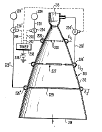 THE PATIENTS OF HEINZ E. MULLER
THE PATIENTS OF HEINZ E. MULLER
US2816419
H. E. MUELLER PROPELLANT DISPLACEMENT GAS GENERATORS
Filed March 7, 1952 Granted Dec. 17, 1957 US2951336
H. E. MUELLER CHAMBER WALL CASTING PROCESS AND
ASSEMBLY Filed Aug. 8, 1956 Granted Sept. 6, 1960 US3224192
H. E. MUELLER MULTI-CHAMBERED LIQUID PROPELLANT
THRUST DEVICE Filed June 18, 1963 Granted Dec. 21, 1965 US3340588
H. E. MUELLER METHOD OF MAKING HEAT EXCHANGERS
Original Filed Oct. 19, 1960 Granted Sept. 12,
1967 US3925982
H. E. MUELLER FLUID-DYNAMIC SHOCK RING FOR CONTROLLED FLOW
SEPARATION IN A ROCKET ENGINE EXHAUST NOZZLE |
|||||||||
|
"Reviewers for Journal of Spacecraft and
Rockets, January 1-October 1, 1967", Journal
of Spacecraft and Rockets, Vol. 5,
No. 1 (1968),
pp. 2-2. doi: 10.2514/3.59584
|
|||||||||
|
scan Weltraumfahrt
Zeitschrif fer Raketentechnik
1958
|
|||||||||
|
Some Of Heinz Muller's
Books that are in the |
|||||||||
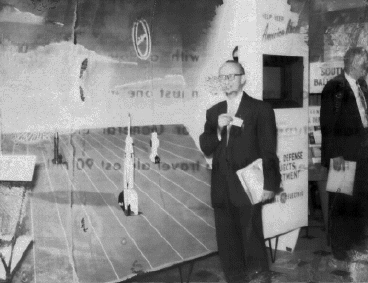
American Rocket Society |
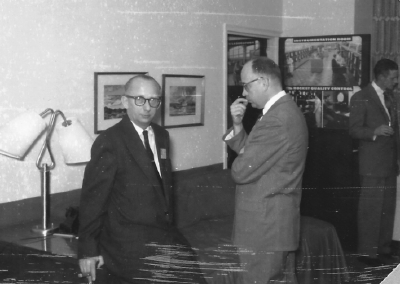
American Rocket Society
|
||||||||
|
|
|||||||||
|
|||||||||
|
Did Heinz Muller
have any |
|||||||||
| Gartmann The Adventure of . Space travel materials created which the gravity oscillations dur 11 leave, ie substances that are weightless. So I'll have Kerper establish that regardless of the Anziehungskr II the Weltkorper float in space and their Besohleun • tions received by the Weltkorpern. Noeh wiohtig r but was, Dab them in the space of "directional thrust" ALH Tool for Verfiigung stood. This was nothing andor as the application of RiickstoBprinzips. It is for di ( amazing imagination of Kurd Lasswitz denote 1, he Dab this s important factor of the later development has already anticipated at that time. Some of that waS In 1897 only in his imagination le bte. Inzwisohen Wid. become sensitivity: wireless telegraphy, the Tel _ phony, the Bildiibertragung, television, the "R _ Pulsor. "Other blie b until now unsolved or is unlos bar ' as the weightless material, the Repulsit, the sore 1'- same Retrospectively, with the one in the past may look the amiisante Tastkunst the Martier, di Slides and rolling Stra13en. Helmut von Zborowski discussed with his fellow students Eugen Sanger mainly the Riiokstoli. drive, the two most interested. In Oberth's first work they soon find more suggestions and di Possibility, by attributed their problems themselves. Del ' Way of the literary imagination in the niichterno Realm of rocket flight technique is difficult durohdringlichen by a Wire entanglement of many mathematical equations obstructed. While Sanger on the path with the Study continues the flight sciences, devotes SiOH Zborowski initially transiently the water line construction. In January 1934, he found his life's work; he goes to the aircraft engine of BMW in Miinchen. It is a fateful EntschluB, because in these works is the young, imaginative graduate Engineer gro13er importance ascend. 226 Always strong now tie him problems del 'engine research. After two years, he transferred by BMW Aeronautical Research Institute in Braunschweig. Professor Dr. A. Busemann has requested it. He is Deputy Department head in the gas-dynamic Institut del ' Research Institute, and soon after the Priifstandsleiter AuBenstelle Dare, the Eugen Sanger with the means of Air Ministry built on the heath. Here he renewed his friendship with the man and country leads with him many evening and nocturnal Fachgesprache, from which gradually to new ideas, the Rocket Trie bwer ken emerge. Also Zborowski acquires very quickly the German Staatsbiirgerschaft. When the missile tests on the new Priifstand are underway in Dare, he returns to the Bavarian Motor works Zuriick to now his plans in the industrial research and development put into action. III The Bavarian Motor Works had at the turn of 1938/1939 from the Ministry of Aviation to order to the development of rocket engines for remote-controlled Get bullets and fast airplanes and began unverziiglich for suitable Personliehkeiten umzutun for the new development branch. One remembered Helmut von Zborowski, del 'already in Miinchner engine plant of the company had been tatig and now rocket-technical research in Braunschweig durohfuhrte. Abschatzenden Del 'successful young engineer sharply with the View brings an impressive number of patents with. turned to the new He has an unusually clear Idea of what he will do now. His mental Superiority, which is often interpreted it as arrogance, 15 * 227 Is fiir employees often almost unbearable, however succeed it his Liebenswiirdigkeit always, the resentment wrinkles on their foreheads to smooth again. Concerns and objections he maintains with friendly lassiger gesture aside to push. He refreshes others opinions are valid and sets but mostly by its own. His inflexibility makes the Directors occasionally ratios, his work ethic rubs with others. His sarcasm is atzend as the nitric acid, with which he works. If he imperceptibly corners of the mouth ironically pulls down and with half-closed eyes smilingly quietly says, "Go's, Leiteln, you're's me a few sehrage Fi.irsten ", then it is serious, and the designers and Test engineers rub together, and work goes on smoothly. In the summer of 1939, before the re-entry, berat Helmut von Zborowski the BMW Group in the planning and construction of the Raketenprufstande, the built in quick succession be. Del 'Group owns north of Berlin, a suitable terrain. There are surrounded by dense markischen Pine forest near the villages Basdorf and Ziihlsdorf which the company gehorenden Niederbarnimer Flugmotorenwerke. In a remote, untapped Corner of weitlaufigen Gelandes you had the Prufstan de fi.ir the turbine jet works another development department accommodated. Of which is now a part separated and additionally by security personnel through a fence secured. This is where the ten coarse Raketenprufstande by Helmut von Zborowski. Only those who the blue Show Special passes with the rough red letter "R" can the secret area may enter. During fall the tall pines at Zuhlsdorf to the mighty Betonkldtzen flat crouched in the sand markisehen To make Prufstande place, while in the RGelande Construction workers, pipe fitters, electricians, Schweiber, Kabelleger and specialists in all branches mogliohen del ' Technology start in three layers to build verfaBt 228 Zborowski in Spandau development work of BMWKonzerns a scientific report, del 'the application areas the new special engines gegeniiber the classic propeller drives clearly mark. He realized a favorite thoughts; he propagates the "nitric acid as the best source of oxygen for Fliissigkeitsraketen. This is a crucial fact. Already Sanger had in his book "rocket flight technique" the high percentage Nitric acid as one of the mogliohen oxygen carriers of Rocket propellant combinations mentioned. He himself, however, had stayed with fliissigen oxygen when he own practical missile tests took. Another Oxidizer for rocket engines had in April 1933, the Kiel engineer Hellmuth Walter "discovered", the then the Germania shipyard was tatig and turbines fiir underwater propulsion developed. The hydrogen peroxide, its use as a fuel Walter the electric- Proposed mechanical works in Munich, was then nati.irlich already a well known and much used Fabric. In highly dilute form it was used for the disinfection of the mouth or bleach to the hair. Looking the front of the high concentrations of themselves harmless Liquid had, however, because of their known Friability of a certain shyness. A small Contamination with concentrated Wasserstoffauperoxyd gefUllten Behalters usually sufficed, the whole thing exploded to bring. It is this property then led to the inclusion of Wasserstoffsuperoxycls in the young rocketry. The Decay brauehte only to be directed and controlled, if you fast effusing from a chamber RuckstoBmassen wanted to get. Although the resulting Gas at a temperature of several hundred degrees Celsius besaBen, was called the betreffenclen simple and unwirtschaftIichen Missiles random "cold" engines. 229 They were "HEW" if you alcohol or hydrazine hydrate injected into the decaying hydrogen peroxide. Then, the hydrogen peroxide was exactly as oxygen supplier as nitric acid or del 'fhissige oxygen. Hellmuth Walter began in 1933 with corresponding Preliminary experiments. Slowly he groped his way to the little-known motor abilities del 'dangerous liquid approach, which lost its terrors, when compared with del 'NECESSARY prudently managed. The in on July 1, 1935 gegriindeten Walter works resulting in Kiel "Walter Engines "were all on del 'basis of Wa ~ serstoffsuperoxyds designed and constructed. Ends In 1936 Reaches 1000 kg of thrust. Was best known del 'engine for the series of fighter Me 163 B of Messerschmitt, which for the first time the speed limit iiberschritten of 1000 kilometers del 'hour could be. As the Me 163 B reproduced with their same comet tail the sky over Germany appeared and the pilots del ' bombers flying into Union confused, they wrote the Year 1944. They had laboriously learned, with the explosive 'deal bottle in del. Thirteen years ago fell del 'investigator Dr. Wahrmke and two of his fellow. employees in an experiment in del 'Experimental Station West of the sliding square Kummersdorf a serious explosion to the victim. Dr. Wahrmke had hydrogen peroxide and Alcohol mixed in a container in order to jointly by a single valve in the rocket combustion chamber to . Send That was nat.urlich tremendously dangerous, back-and- again verfiihrt burning WiBbegier also prudent Researchers to carelessness. Dr. Wahrmke was to del 'Gofahr probably conscious of. He called on his staff, don To leave Prufstand. They refused and stayed. The Ziindung in del 'combustion chamber via wore abruptly <Amphibian the connecting pipe into the fuel tank. A g. waltige explosion tore the whole Prufstand. 230 Dr. Wahrmke and two of his staff were killed instantly That was the first and only explosion in del 'rocket development the Army Ordnance Office, the death toll. Over del 'years were different Tarnbezeichnungen for hydrogen peroxide used. It was called it Aurol, auxilin or Ingolin. When "T-Stoff" it is schliefllich entered the rocket history. With del 'introduction del' highly concentrated nitric acid Helmut von Zborowski had in 1939 a revolution del ' Rocketry launch ki: inside. Abel 'of the rocket engineers was provisionally not ready with flying To wheel lugs in the new camp. Man feared the aggressive nitric acid, a water-clear yellowish Liquid with terrible atzender effect. One drop of suffices to del 'bloBen skin, a fear variable, difficult burn wound healing. As del 'new' fuel ' schliefllich his qualities in hundreds of successful Missile tests had virtually been disclosed, it was for a shift del 'other, now also well-advanced Developments too late. Therefore, it was in del ' German rocket development of the second world war three groI3e oxygen carrier for rocket engines: the liquid Oxygen, hydrogen peroxide and the nitric acid, Zborowski was not of approximately the nitric acid come. He had the pros and cons very carefully weighed against each other. This was not EntschluB, the you could put into a sleepless night. Many Months miihseliger calculations went about it. Inquiries muBten be confiscated. What cost Hydrogen peroxide, Flussigsauerstoff, nitric acid 1 What substance dignity in mass production be cheaper 1 Is nitric acid roughly manufactured industrially? The IG Farben AG. could provide virtually any desired quantity! What are the physical characteristics del 'ag- 231 aggressive liquid 1 One could in Chemiebiichern dariiber look up, but where there were pipes, pumps, Valves, seals, control apparatus fiir nitric acid, the you giinstigster in complicated engines power to weight ratio could use 1 Research and Industry wiirden be jointly capable of anything relevant field for Verfiigung to ask. The decisive factors were the thermodynamic Calculations. They were promising. Nitric acid having a high specific weight. One liter of is heavier than a liter of water urn 50 percent. One can So more nitric accommodate in the same rough Behaltern, than about Fliissigsauerstoff or hydrogen peroxide. The heiBt, the volume-based specific Impulse of rocket Advised with nitric acid is better. Theoretical evidence is usually only fiir the like-minded Expert impressive. The skeptic will be nul 'let iiberzeugen by facts. Attempt Serge bnisse are facts. That is why Zborowski sends to, in Ziihlsdorf with the unknown fuel Salpeterssure to experiment. At his side is his first Versuohsmann, del 'wieself1inke Dipl.-lng. Heinz Muller from Saxony. Both have the vague Gefiihl, DAB they put themselves in danger. Abel 'they have no idea how Grots this danger in reality is. As the experienced Ohemiker of Spandau Zborowski work arrangements in Ziihlsdorf see them are literally the hair on end. You chen po on their Ohemiebiicher and einschlagigen experience in Dealing with such a strong oxidizers. Abel 'they also do not know how to nitric acid and methyl alcohol can bring together and entziinden. "Ergo whose "explains del 'incessantly cigarette-smoking Zborowski with emphasis, "ergo the MUB to it try ". In a fully enclosed Aluminiumbehalter four punch cut. A coarse rectangular in dor 232 Page, through which you can look into it. In addition, a small round fiir the fuse, with del 'you want ziinden. And on top of the lid for two more Einfiihren del 'two Lines. By line # 1If pressed for nitric acid, by Line No. 2 methyl alcohol. Nothing happens. The two liquids mix. Female vapors and yellowish-brown nitrous gases are visible. This is everything. You can see the mixture of the explosive-like Oharakter not. The container is now a sharp Bomb. A spark dignity suffice, they explode to bring. Muller MIBT the temperature: "This stuff is warm ". Abel 'it does not does not explode, even as the Mixing ratios are varied. Del 'second Versuoh. Re-inject the two liquids in a fine jet into the container. The rays intersect. Abel 'time is at the same time a burning Fuse into the container held. A moment of breathless Voltage. No man can say at this moment, what will happen now. If del 'container in the air fly 1 A faint muffled bang Iaflt the experimenting Engineers jump. Then swells scheulslioh stinking, beiBender smoke from all Behalteroffnungen. The klagliche flame behind you can barely see. For the first time, a mixture of nitric acid and Methyl alcohol geziindet! The experiment is repeated. Ten times, twenty times. Sometimes the Fliissigkeitsstrahlen ziinden, sometimes do not. The mixture is hoohst imperfect, the fuse only primitive tools. Zborowski has march exemplary Happiness. Many dozen times later are the combustion chambers fiir nitric acid and methyl alcohol explodes. This time nothing happens like. The two liquids behave so obediently as if it were bright Beer and schnaps. 233 The restless spirit of invention Zborowski shapes the kiinftige Combustion chamber fiir Salpeteraaure and methyl alcohol. The unzuverlassige fuse is replaced by a powder cartridge, a sufficient temperature in the combustion chamber generated at the entziinden the fuels can, the cartridge will rest of the combustion gases out rage, the combustion itself is constantly and without further Ziindung ahead. Thus, it is thought, but how is the harsh reality on the now completed production Doppelprufstand in Ziihlsdorfer R-terrain look 1 Other employees have now begotten Zborowski. In the experimental field Heinz Muller now acts together with the ambitious Elmar Mucha. In Spandau plant , the always friendly Hans Schneider a solid Design department together. In the next room makes the already graying Werner Singelmann on churning merkwiirdige, intelligent missile projects. Already on friihen morning rattles his unbekiimmert loud Gelaehter through the glass swing. In drawing cabinet Stacking the Entwiirfe. Since none of the Project numbers mer ken can you einpragsame them Name such as "Jaws", "comet" or "silver fish" given. One of the multiplier holds drawings that already outdated were before the last line was drawn to it. This Draft received a unvergeBlichen name: "The old Singelmann ".'s Name carries over to the gutmiitigen Designer, although it "the old Singelmann" of clamping force receives it with his young employees. The fight begins. There is a double rings; not only the brittle matter MUB in numerous experiments Be conquered step by step, and the skepticism Ministry of Aviation is to surmount. Zborowski now does the same bose experience as Eugen Sanger six years earlier with the Federal Ministry of Defence osterreichischen in Vienna. The Forschungsabtol- 234 ment of the Reich Ministry of Aviation has an opinion elaborated: nitric acid is fiir as propellant rocket impossible. One day, the group leader is fiir jet drives in the Reichsluftfahrtministerium way to Ziihlsdorf. Zborowski is meanwhile warned by phone: Dr. Beck has the strict prohibition for any attempt with nitric acid in your pocket. In Ziihlsdorfer R GeHinde one is edoch [ well prepared. Zborowski receives the Officer of the Minister with usual charm. He's on his guard. Bever Dr. Beck can open his briefcase to the fateful Prasentieren to writing, he is to visit a Combustion chamber experiment invited. Delighted says e ~ to. The Prufstand 1 is carefully prepared. The black Manometertafeln with the whites scales of MeBinstrumente are labeled clean: combustion chamber pressure, Forderdruck, Injection pressure, Kiihlmitteldruck, thrust. Pressure regulators, control valves and pipes are by Color-coded: blue fiir nitric acid, yellow for Methyl alcohol, Griin for highly compressed nitrogen. In the next room sum measures the relay. Switch crack, as the Priifstandsleiter attempt a trial basis "blind" on, There is no pressure on the Behaltern. On the stable iron trestle behind the meter-thick, light gray concrete walls depends clamped the combustion chamber. They can through the slits, by double- Geschiitzt bulletproof glass, watching good. Through the Horn, which for Verstandigung space between the observer and Pmfstandskoje serve echo the last Harnmerschlage the fitters. Now come Manner, the wart in the gleaming sch Rubber jackets look like, in and heave divers their tool boxes on the Banke. Window and Tiiren are closed. The experimenter, Elmar Mucha, driickt the Alarm button. On the roof of a Prufstands begins 235 Horn quack loud and penetrating. . Alert fiir aIle r The Pfortner schlieflt the Tiir for R-terrain. Now may no one in or out. Relentlessly he holds with the Schliisselbund in the hand guard. The master Simbal and Koslick clasping the thick Hand wheels of the regulating valves. High Compressed nitrogen gushes from the thick-walled high-pressure cylinders in Side room with merkwiirdig ringing, Gerausoh in the Treibstoffbehalter who sticks in concrete pits. But long, then the pressure is equalized. The Manometerzahlen stand on the gewiinschten number. . Mucha druekt the button labeled "Ziindung" down. From Diise the combustion chamber ride gray Smoke with fine hiss. Button # 2: The fuel valves open up, This is the crucial moment. Explosion or Ziindeinsatz, which is now the anxious question. Fiir the fraction of a second geschiehtnichts.Nur the Ma. nometernadeln twitching nerves. The liquids Stromen r Suddenly a short, sharp report. The fuels who ignites the powder gases heiflen the Ziindpatrone. A mighty cloud of smoke pours from the Brennkammerdiise. Even grab Simbal and Koslick in the Rader of the regulating valves. This is a work that force and FingerspitzengefUhl required. Singing and ringing gushes more and more PreBstickstoffin the 'I'reibstoffbehaltor. The Forderdruck increases, the smoke cloud is long, from the sharp hissing sound is echoing thunder. VolIschub r The smoke clouds are gone, before the Diise is clear and transparent of the three-meter-long Jet of fire. He looks almost korperlieh, Only a slight tremor and vacillation, an imperceptible comings and goings of darker vibration nodes treason, DAB because drauBen raging fire gases with incredible speed currents, The test time is measured in seconds. But dreiflig seconds of this magnificent spectacle are as 236 ten minutes. . When the fuels are verbrauoht and the Valves are closed, is apparently a long time passed. Dr. Beck is greatly impressed. He driickt Zborowski moved his hands: "l you begliickwiinsche to this em ErfoIg. And I am glad you followed this path DAB and now but used hydrogen peroxide have. " A fine smile plays around Zborowski lipped Mouth as he replied: "What do you believe what you just have seen, Dr. Beck 1 "The Representative of the Minister senses the Faile. Hesitating he replied: "l said it already - hydrogen peroxide. This clear Flame, safe fuel use ... " Zborowski leads to have become uncertain guest into the open, where the fitters Thiers and Baer just the small remaining Amounts of fuel out of the lines spiilen. From the geoff Neten glands fall beady heavy drops, pull the aIle small woman with Fahnchen to: nitrogen oxides. Dr. Beck realizes he Dab just a perfect rocket test with the verponten, unmoglichen nitric acid has attended. The official letter with the strict prohibition of all Experiments with nitric acid is not ausgehandigt. The Breakthrough, the direction for the rocket development Bavarian Motor Works is uniquely determined. One can fiir experimental purposes aufWasserstoffsuperoxydbasis fall built Starthilfsgerat endgiiltig leave. Nonstop roll now yon to tank car with a high percentage Nitric acid in the rocket factory. IV Helmut von Zborowski aIle has its hands full, because the rocket factory waohst as a tropical plant. From the groups are departments. Zborowski is main- 237 department heads and draws as an officer in the Directorate a. In Ziihlsdorf are ten well furnished Prufstande. A leistungsfahige experimental workshop is available. The coarse workshops in Spandau and Miinchen start To deliver parts of the engine, the fiir the series of-Iagers Me 163 B is determined. At the same time developed Walter in Kiel for this aircraft engine to be Wasserstoffsuperoxydbasis. The Reich Air Ministry wants "to two legs "are. Incidentally Zborowski still has time to technical improvements propose fiir piston engines. Back in 1939, has he a method for high charging and intra-en Kiihlung yon aircraft engines worked. The commander del ' Hohenaufklarer it is, possible by a representation del ' Performance improvements made sehmackhaft. High and fly to be able to, is del 'desire diesel' Manner, which are in standigem hard use. Man is willing to to taste fabulously promising method, as the keyword "water injection" falls, it is the self- for engine engineers of the time difficult veratandliche Basis del 'improvement. Del 'commander roars on: "Are you insane - with water you want my planes operate 1 "Emport he refuses. Now, the process in engine development is yon BMW used. The progress is unmistakable. The Academy fiir aviation research has noted Also, the Office for warship building in the High Command del 'Navy sustaining a suggestion yon Zborowski. Is a method for high charge yon diesel engines. There follow a number of technical and scientific Reports, lectures in the Ministry of Aviation and VOI ' del 'Academy del' aviation research, meetings of the Heereswaffenamt and del 'Lilienthal Society. Zeitgemafle leave "honors" nioht coming. The War Merit Cross Second KIasse follows soon 238 first KIasse with Sohwertern and - briefly VOl'Kriegsende - nor del 'proposal to the Knight's Cross of the War Merit Cross, that at this time Wernher yon Braun in Peenemiinde fiir the "V 2" has received. In the fall of 1942, Helmut yon Zborowski married the image beautiful, einundzwanzigjahrige Isolde Ottrnann that in Missile factory yon Hellmuth Walter at Kiel had besohaftigt. In Berlin, she had met. Walter loses a Associate, Zborowski wins a lovely woman he is faithful in good s and difficult years to the side. Devouring Once again, for the last time in this all forces War, Zborowski can a short holiday begun, He ride, with his young wife loved ones in the Styria to his J to indulge agdleidenschaft. Chuckling he registered, he Dab on this honeymoon two has hunted stags and chamois. Afterwards, work with verstarktem pace. At about the time when the combustion chamber fiir the engine the rocket Jagers arrives in Ziihlsdorf, I will by . Mediation of the Reich Air Ministry and del 'German Research Institute fiir aviation research into the secret R-terrain added. It's winter, and the Priifstande are buried under a thick blanket of snow. Severity Pave tankers for nitric acid and methyl alcohol be sliding their way through the sprawling terrain. In the gray concrete fortresses drohnt. AufPriifstand 3 rushes del 'small gas steam generator fiir the engine as a locomotive ablaBt steam. On Priifstand 4 sputters a model combustor that soon their service will have done. On the Prufstanden 5 and 6 beyond the Shia ended up high Sand Walles hammer nor the construction workers. There the full thrusters will move. Further back in the forest, hidden yon scarf-pines, drawing SiOH already the foundations del 'Prufstande 7 and 8 from. On Priifstand I, del 'right half of the roughly like an- 239 directed Doppelpriifstandes, graduated engineer Kurt Sohr patiently his miihseligen series of experiments with the peculiar differential piston engine of Zborowski. It based on a grandiose idea: Part del 'in del' combustion chamber combustion gases generated is used to call the fliissigen fuels. This is a cycle, del 'Award works when all sources of error griindlich are eradicated. But even the slightest deficiency brings the delicate GERAT out of balance. Then rises del 'boost del' is supposed to remain constant, steeply, or he falls. gradually from. Later makes a simple non-return valve meek as a lamb in the gas line the device. This device and as a mil 'the first lasting impression of missile tests. I watch as it plctzlich flies into the air with a tremendous explosion. The entire Establishment of sehonen Priifstandes is destroyed, within several hundred meters all the windows del 'neighboring buildings fragmented. Only the meter-thick concrete walls of the Priifstandes have the force of this detonation was held. A few weeks later the Priifstand is redeveloped. Day and night have pipelaying and Schweiber worked. New test devices are delivered. The experiments be continued and completed successfully. Nevertheless, the disaster happened in Peenemiinde West, a terrible tragedy that a Mensohen life and another cost the health. The unit had been fully developed, so it Dab the Air Force could be iibergeben. It should to drive gefliigelten a glide bomb used. The small Sohr and an engineer from the R plant in Ziihlsdorf judged the Test pattern for her Vorfiihrung. As Sohr the cable anschlieBen wanted to Ziindpatrone, it happened. In the observation room, an engineer had playfully the power switch wrapped. It was criminal Carelessness. For thus was the electrical safety 240 Schniu by. gekiihlte Roketenbrennkammer [iir Solpetersiiure and "Tonka" by the engine of the rocket projectile "X 4" First Versuchsgeri.it [iir the Raketengeschofi "X 4" in operation on BMW Priifstand in Berlin (1943) Rocket engine of Hellmuth Walter, Kiel, for the fighter Me 163 B, with a grof3en and a small Brennkamrrier BMW turbojet with zusiitzlichem rocket engine (Top left) by Helmut von Zborowski circuit of the device operation aufler been set, which safe Zimdung guaranteed before the fuels were put under pressure. Now could before Ziindung in the combustion chamber a Misehung of nitric acid and methyl alcohol accumulate. The whole THE MONITOR flew apart with tremendous Get6se. The fitter hit a rough splinters from both legs; He died minutes later. The engineer Kurt Sohr was seriously injured. The combustion chamber, which I iibernehme in the summer of 1942, is about one meter long. It weighs about twenty kilograms and to generate a thrust force of 1,500 pounds. Through four Dralldiisen is nitric acid, by flieBen four other is methyl alcohol in the combustion chamber. The Fire wall of the chamber is stahlernen fliissigkeitsgekiihlt. Zborowski has now greatly improved the Ziindung. In the search for other fuel combinations - Thousands of firing experiments are carried out been - he is disturbed ollen to a whole new kind of substances. These react by itself spontaneously as soon as they brings together. Meter-high jets of flame arise when you a few drops of nitric acid in a bowl full of van this en liquids fall feast. Dr. Noggerath, employee van Professor Dr. Lutz at the Technisehen College in Brunswick, called this selbstziindenden combinations later "hypergolic". Full of zeal Zborowski stiirzte with its chemical Experts on the new opportunities. He is the first, the working with such selbstziindenden rocket fuels. It has become more cautious. Combustion chamber explosions have, destructive force of Oerate disclosed. As you can now best the possibilities of self-reaction fliissiger rocket propellants scan? Heinz Muller appeared an old rags in aniline. Then he schiittet a little nitric acid dariiber. It works beautifully. A bright red flame ziingelt up spontaneously. 16 Gartmann 241 After a few hours in the X-terrain no cloths raise more. Mucha dragging a bale Cotton cause he has wheedled the storekeeper. But the getrankte with aniline cotton smokes blob. Dbelriechende Evaporate erfiillen the room. It is jinxed. Swabs burn perfectly, gewohnliehe cotton burns do not. Chemists solve the riddle. Found in the swab they tiny traces of copper salts · acting as catalysts effect. This is an important finding. One can therefore with catalysts selbstzundende Treibatoff combinations . win You can wear reacting liquids zundwilliger make. The next experiment proves it: with a little copper salt impregnated cotton burns also if you trankt with aniline and nitric acid darubergieBt. A could. This was In . seen We are. 244 The . seen is. The Consideration. will. One 247 Ground. Del |
|||||||||
